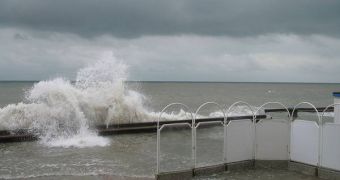Experts analyzing the Atlantic seaboard on the East Coast of the United States, from Maine to Florida, have determined that the average level of high tides on the entire stretch of land is about two feet higher than anticipated, for yet unknown reasons. The measurements were conducted during mid-season, when the tides were highest in the year. Experts who made the find say that they are puzzled as to what is causing this phenomenon, adding that global warming would not have acted this fast, and that the tides do not resemble those caused by large amounts of ice melting simultaneously.
“The ocean is dynamic. It’s not uncommon to have anomalies like this but the breadth and the intensity and duration were unique,” the National Ocean and Atmospheric Administration (NOAA) Tide and Current Program Director, Mike Szabados, explains, quoted by Wired. The expert adds that the large tide is currently receding, and that it is now confined only to the general region of mid-Atlantic states.
The federal agency is working at full capacity, in order to understand what just happened and why. Already, Szabados' group has put together a preliminary report on the wind and water current patterns that may have influenced the formation of the larger tide. The paper will be released next month, after the last finishing touches on it are set. “I’m quite sure that there will be more intensive analysis of this event. By no means will this report be the definitive answer to anything. Further assessment of this event should be encouraged to better understand the phenomena,” the official shares.
“It’s such a long time scale that’s working in this process that we don’t sense it going on like we sense a hurricane coming and going. A subtle but persistent pattern that affects the whole North Atlantic ocean: It’s acting without giving any immediate clues that it’s going on until we see, ‘Whoops, the sea levels are higher than normal,’” Virginia Institute for Marine Studies professor emeritus of oceanography John Boon explains. “When I’m comparing [global trend] cycles, I see that some of the highs in these decadal cycles coincide with El Niño events. It’s not to say that one is caused by another, but the degree of association is somewhat surprising.”
At this point, both researchers agree that more studies are needed in order to assess the exact nature of this change. They say that this year's high tides may be the result of a larger sea rise trend, but that, at this point, insufficient data are available to confirm or dismiss these claims.

 14 DAY TRIAL //
14 DAY TRIAL //